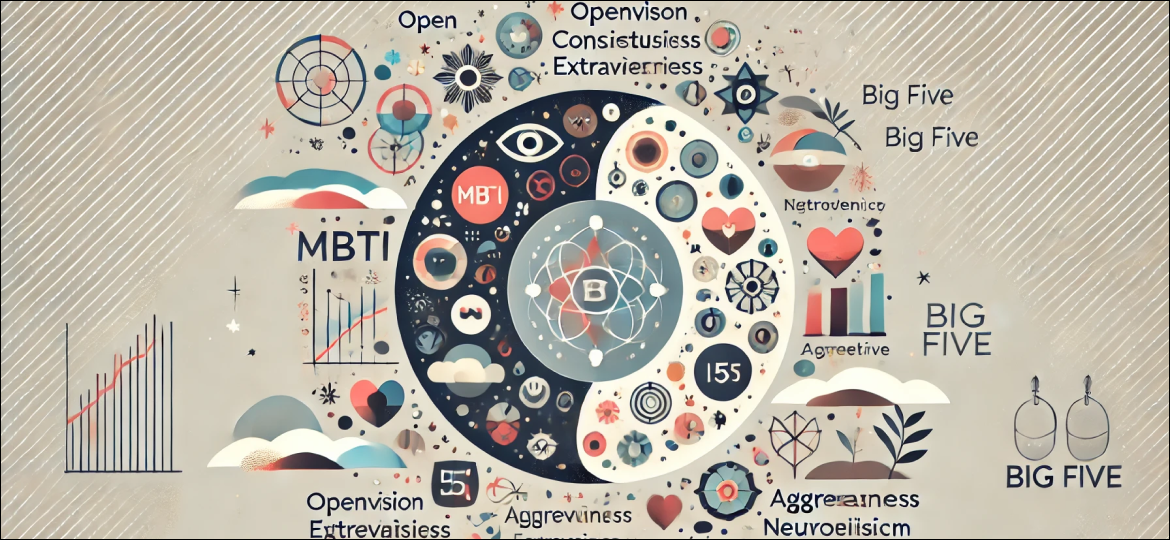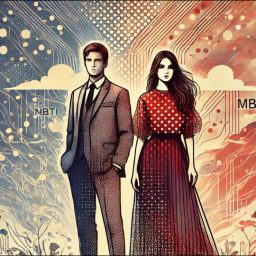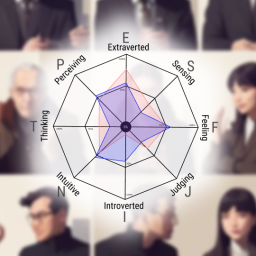
MBTI vs. Big Five: How These Two Personality Theories Differ and Overlap
Understanding personality is a key component of building strong, meaningful relationships. Two of the most well-known personality frameworks—Myers-Briggs Type Indicator (MBTI) and the Big Five Personality Traits—offer unique insights into how we think, feel, and interact with the world. While both systems aim to describe personality, they differ in approach, structure, and practical application.
In this blog post, we’ll explore the differences and overlaps between MBTI and the Big Five, and how each system can help you better understand yourself and others.
MBTI: A Snapshot of Personality Types
The Myers-Briggs Type Indicator (MBTI) is based on the psychological theories of Carl Jung and was developed by Katharine Cook Briggs and her daughter Isabel Briggs Myers in the mid-20th century. The MBTI sorts individuals into 16 distinct personality types based on four dichotomies:
- Introversion (I) vs. Extraversion (E): How you direct your energy (inward vs. outward).
- Sensing (S) vs. Intuition (N): How you take in information (practical details vs. abstract ideas).
- Thinking (T) vs. Feeling (F): How you make decisions (logic vs. personal values).
- Judging (J) vs. Perceiving (P): How you organize your life (structured vs. flexible).
Your MBTI type is a combination of these preferences, resulting in a personality profile such as INFJ, ENTP, or ISFP. The MBTI is often used to help people understand their communication styles, decision-making processes, and relationship dynamics.
Strengths of MBTI:
- Categorization of Personality: MBTI provides a clear, easy-to-understand categorization of personality types. It gives individuals a defined personality “type” that offers insight into their behavior, motivations, and interactions.
- Focus on Preferences: MBTI focuses on psychological preferences, helping individuals explore how they perceive the world and make decisions.
Limitations of MBTI:
- Rigid Categories: One of the critiques of MBTI is its binary nature. It categorizes individuals strictly into one of two options (e.g., introvert or extravert), even though many people may exhibit traits of both.
- Lack of Scientific Rigor: MBTI has faced criticism for its lack of empirical support, and some researchers argue that it oversimplifies human personality.
The Big Five: A Trait-Based Approach
The Big Five Personality Traits, also known as the Five-Factor Model, is a more scientifically grounded personality framework that describes personality in terms of five broad traits:
- Openness to Experience: Curiosity, imagination, and willingness to explore new ideas.
- Conscientiousness: Organization, dependability, and attention to detail.
- Extraversion: Sociability, assertiveness, and enthusiasm.
- Agreeableness: Compassion, cooperation, and trust.
- Neuroticism: Emotional stability and susceptibility to stress.
Unlike the MBTI, which places individuals into distinct categories, the Big Five measures personality traits on a continuum. For example, a person might score high, medium, or low on extraversion, indicating varying degrees of sociability and assertiveness.
Strengths of the Big Five:
- Scientifically Validated: The Big Five is widely supported by empirical research and is considered a robust framework for understanding personality.
- Continuum of Traits: The Big Five recognizes that personality traits exist on a spectrum, providing a more nuanced understanding of individual differences.
Limitations of the Big Five:
- Less Accessible: The trait-based approach can feel more abstract and less immediately relatable than MBTI’s clear-cut personality types.
- Lacks Practical Focus: While the Big Five is scientifically rigorous, it doesn’t always offer specific guidance for personal growth or relationship dynamics in the same way MBTI does.
How MBTI and the Big Five Overlap
Despite their differences in structure and application, MBTI and the Big Five do overlap in several key areas, offering insights into how certain traits and preferences align:
1. Extraversion/Introversion
Both MBTI and the Big Five include a dimension related to how individuals engage with the external world. In the MBTI, this is the Extraversion (E) vs. Introversion (I) scale, while in the Big Five, it’s measured by the Extraversion trait. In both systems, extraverts are characterized by sociability, high energy, and a preference for external stimulation, while introverts are more reserved and focused on internal thoughts and ideas.
2. Openness to Experience and Intuition/Sensing
One of the most significant overlaps between MBTI and the Big Five is between the MBTI’s Sensing (S) vs. Intuition (N) dimension and the Big Five’s Openness to Experience trait. In the MBTI framework, intuitive types (N) are more focused on abstract thinking, future possibilities, and imagination, whereas sensing types (S) are more grounded in concrete, practical details. This closely correlates with the Big Five’s Openness trait, where individuals high in openness are imaginative, curious, and open to new experiences, much like MBTI’s intuitive types. Those lower in openness, like sensing types, tend to prefer routine, tradition, and tangible realities.
3. Decision-Making and Emotional Stability
The MBTI’s Thinking (T) vs. Feeling (F) dimension has some parallels with the Big Five’s Agreeableness trait. While they measure slightly different aspects of personality, both systems address how people make decisions. Thinking types (T) tend to prioritize logic and objective criteria, while feeling types (F) are more empathetic and consider the impact of their decisions on others. In the Big Five, high agreeableness is associated with being cooperative, compassionate, and motivated by harmony, which can resonate with MBTI’s feeling types.
Additionally, the Big Five’s Neuroticism trait somewhat overlaps with emotional tendencies captured in the MBTI. Individuals who score higher on neuroticism are more emotionally reactive and prone to stress, which may relate to certain aspects of how MBTI’s feeling types experience emotional situations.
4. Organization and Structure
The MBTI’s Judging (J) vs. Perceiving (P) dimension aligns with the Conscientiousness trait in the Big Five. Both dimensions explore how people approach structure and organization in their lives. Judging types (J) and individuals high in conscientiousness prefer order, planning, and structure, while perceiving types (P) and those lower in conscientiousness tend to be more spontaneous, adaptable, and flexible in their approach.
Key Differences Between MBTI and the Big Five
While the two systems overlap in some ways, there are significant differences:
1. Trait Continuum vs. Binary Categories
The biggest distinction between the Big Five and MBTI is how they categorize personality traits. The Big Five views traits as existing on a spectrum, allowing for more nuance, while MBTI places individuals into binary categories. For instance, in MBTI, you are either an introvert or an extravert, while the Big Five would measure how introverted or extraverted you are.
2. Focus on Preferences vs. Traits
MBTI is more focused on preferences—how you prefer to gather information, make decisions, and organize your life. It suggests that your behavior is based on your innate preferences. The Big Five, on the other hand, is based on traits that are observable and measurable, such as openness, agreeableness, and neuroticism, which are considered stable over time.
3. Practical Application vs. Empirical Research
MBTI is often used in career counseling, team-building, and relationship dynamics, focusing on practical applications of personality types. The Big Five is more commonly used in psychological research, as it provides a detailed, evidence-based framework for understanding personality without offering specific “types.”
Which System Is Better for Understanding Relationships?
Both MBTI and the Big Five have value in understanding relationships, but they serve different purposes:
- MBTI is ideal for individuals seeking self-awareness and relationship insights based on preferences. It can help couples understand each other’s communication styles, decision-making processes, and emotional needs. For instance, knowing whether your partner is a Judging (J) or Perceiving (P) type can clarify differences in planning and flexibility.
- The Big Five provides a more detailed and scientifically validated look at personality traits, offering insight into traits like agreeableness and conscientiousness, which are important for relationship harmony. High levels of agreeableness, for example, often correlate with greater empathy and cooperation in relationships.
At FindingYou, we prioritize personality compatibility based on MBTI’s framework, focusing on similarity in key areas that promote long-term harmony. While “differences attract” might bring initial excitement, we believe that “similarity binds” when it comes to building lasting, meaningful connections.
The Bottom Line: Complementary Tools for Self-Understanding
Both MBTI and the Big Five offer valuable insights into personality and compatibility, and each system has its strengths. Whether you’re drawn to the clear-cut categories of MBTI or the scientifically validated traits of the Big Five, both can enhance your understanding of yourself and your relationships.
At the end of the day, personality is complex, and no single system can capture every nuance. By exploring both MBTI and the Big Five, you can gain a more complete picture of who you are and what you need to thrive in a relationship..
Conclusion: MBTI, Big Five, and the Future of Personality-Based Compatibility
Both the MBTI and the Big Five offer valuable insights into personality and compatibility, with each system bringing its own strengths to the table. While the MBTI provides clear personality types that are practical for understanding relationship dynamics, the Big Five offers a more nuanced, scientifically validated approach.
At FindingYou, we’ve built our platform around MBTI’s framework, helping individuals find meaningful, long-term relationships by focusing on similarity in key areas. However, as we continue to evolve, we’re excited to announce that we plan to integrate the Big Five personality traits in future versions of our app. By combining the best of both systems, we aim to offer a more refined, data-driven approach to assessing love and marriage compatibility, helping our users connect on even deeper levels.
As personality psychology continues to advance, so does our ability to foster stronger, more fulfilling relationships—and at FindingYou, we’re committed to being at the forefront of this evolution.

